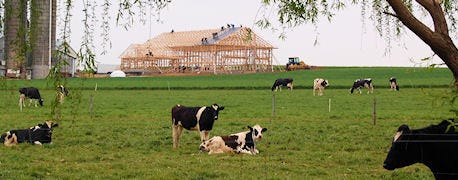June 14, 2012

Here's a quick summary of how dry fertilizers can be used by graziers to boost pasture productivity. They come from Phillip Sylvester, University of Delaware Extension agronomist.
Ammonium sulfate (21-0-0-24S): Contains 21% nitrogen and 24% sulfur in the dry form. It's a good fertilizer to apply in spring and summer. It supplies sulfur, necessary for plant growth and limiting in some soils.
This is one of the most acidifying fertilizers, so be sure to soil test regularly – particularly the top two inches for soil pH, so lime can be applied as soon as it's needed.

KICK UP PASTURE GROWTH: Now's the time to plan a three-stage pasture improvement strategy to boost grazing productivity.
When legumes make up 25 to 50% of the forage available to grazing animals, N should be limited to no more than 25 pounds per application. If legumes make up over 50% of the available forage, no N will be needed.
Urea (46-0-0): Contains 46% N, the highest analysis available in dry form. Apply it before rain to minimize volatilization losses. Works well as a spring time green-up fertilizer because of lower temperatures and increased chances for rain to reduce volatilization.
MAP or monoammonium phosphate (11-52-0): Contains 11% N and 46%
phosphorus. It's a good fertilizer to blend with other components to make a custom blend.
Muriate of potash or potassium chloride (0-0-62): Contains 60-62% K. Again, use a soil test to determine application rates.
Pastures with legumes (clovers, alfalfa, vetches or lespedeza) require a lot of K. It should be applied in two applications – late spring and late summer or early fall.
Potassium magnesium sulfate or K-Mag (0-0-22-11Mg-22S): Contains 22 pounds of K, 11 pounds of magnesium, and 22 pounds of sulfur. K-Mag supplies magnesium and sulfur and is a good fit for legume pastures, especially alfalfa.
Calcium or magnesium (Dolomitic) limestone: Lime is used to raise the pH of the soil for optimal growth by reducing soil acidity and increasing availability of soil nutrients. Again, a soil sample should be taken to determine what's required to raise pH to a desired level. If large amounts of lime are called for, application typically occurs before pasture establishment so it can be incorporated. Small pH adjustments can be made through topdressing.
The best method is to lime before seeding your pasture. It takes a while for lime broadcasted on top to move down through the soil layer and become available for plant use.
Grazing safety?
Grazers often wonder if it's safe to allow animals back on the pasture immediately after liming or fertilization, says Sylvester. "While lime is non-toxic, we normally suggest waiting until after a rain event to put animals back on a pasture just to help the grazer feel comfortable about the application."
The salt content of some fertilizers sometimes attracts grazing animals if it's not uniformly applied and it's not "rained in."
Consider this NPK fertilizer application strategy: The first application should take place in early spring, around green up. A blend of 40 pounds of MAP and 60 pounds of urea would supply 30 pounds of N and 20 pounds of P.
Supply another 30 pounds of actual N and half of the recommended K with 65 pounds of urea and 130 pounds of muriate of potash after the first couple of grazing cycles, around mid-May. The K helps plants tolerate hot and dry conditions.
The last application might be another 50 pounds of N and 80 pounds of K should be applied using 240 pounds of ammonium sulfate and 130 pounds of muriate of potash. It should occur in late summer or fall to supply fall N needs if environmental conditions favor pasture growth.
Splitting the potassium applications prevents creating a grass tetany problem during spring when adding large quantities of N and K all at once during the cool, wet period of spring can reduce magnesium uptake by forage plants.
You May Also Like




